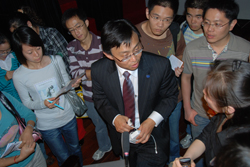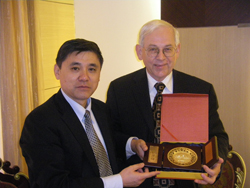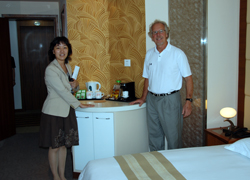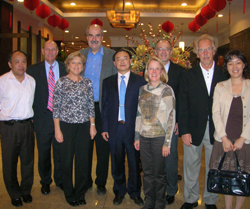 |
Jialin Zheng, M.D., director of UNMC’s Asia Pacific Rim Development Program, is surrounded by eager medical students at Shanghai Jiao Tong University School of Medicine after his presentation Wednesday afternoon. The students wanted to find out more about getting their Ph.D. at UNMC. |
 |
Zhenggang Zhu, M.D., Ph.D., vice president and dean of the SJTUSM, left, exchanges gifts with UNMC’s Don Leuenberger after a lunch on Wednesday. Dr. Zhu will be visiting UNMC on Nov. 3 and 4. |
 |
Gao Hong, deputy director of the International Affairs Office at the Shanghai Jiao Tong University School of Medicine, shows Keith Swarts, director of UNMC Business Services, what a dorm room looks like at SJTUSM. Starting in August 2009, UNMC will be sending up to 12 medical students a year to SJTUSM for one-month stints in China. |
 |
Shanghai Jiao Tong University School of Medicine held a dinner Wednesday evening for this contingent, which that included, from left, Xiaoning Zou, Tom O’Connor, Jayme Nekuda, Paul Paulman, M.D., Gang Huang, M.D., Ph.D., Christine Anderson, Jeff Harrison, M.D., Keith Swarts and Gao Hong. |
Nearly 80 students from the Shanghai Jiao Tong University School of Medicine (SJTUSM) came to a presentation Wednesday afternoon to hear UNMC administers talk about what students could expect if they came to the medical center to get their Ph.D.
UNMC and SJTUSM recently announced plans to collaborate on the first-ever M.D./Ph.D. program involving a Chinese and an American university. Under the program, students take the first two years of medical school at SJTUSM, then go to UNMC for four years to earn their Ph.D. before returning to SJTUSM to finish the last two years of medical school. The schools hope to identify two students per year for this program.
Wednesday’s session included brief comments about UNMC and Omaha by Don Leuenberger, vice chancellor for business and finance, followed by remarks from family medicine physicians, Paul Paulman, M.D., and Jeff Harrison, M.D., on UNMC’s educational training in the clinical and residency setting.
Next up was Jialin Zheng, M.D., director of UNMC’s Asian Pacific Rim Development Program.
Dr. Zheng, who earned his medical degree from SJTUSM, put an exclamation point on the day’s activities with an energetic Power Point presentation on the importance of students earning their M.D/Ph.D.
He stressed the value of having both the clinical and research training for an M.D./ Ph.D. degree. He noted the commitment involved in procuring the dual degree and conceded that it might not be for everyone.
For those wishing to pursue the M.D./Ph.D. tract, Dr. Zheng assured the students that UNMC would provide the support the students will need.
“We can help produce the next medical leaders for China,” he said. “The future is interdisciplinary research. I’m going to work with you.”
Dr. Zheng gave his presentation in English and fielded several questions afterwards. The questions continued to flow in until Dr. Zheng let the students know that he had to take off to catch a plane for Beijing.
As the session ended, Dr. Zheng was deluged with about 20 students coming on stage to ask more questions.
As a casual observer, I had to say I was impressed with how UNMC was portrayed in the presentations. But, I was blown away by the students’ reaction to Dr. Zheng. When it comes to connecting with students, the man is a rock star.
He emphasized to the students that UNMC doesn’t pay lip service to its collaboration with SJTUSM.
“If we promise something, we do it,” he said. “We’re not going to promise something and not do it.”
Afterwards, I cornered Xiaoning Zou, director of SJTUSM’s Project Hope Office. I wanted to know just how UNMC stacks up with SJTUSM’s other collaborating institutions. His response was enlightening.
“We cooperate with different medical schools,” he said. “The relationship with your university I think is the best. You really do something with the faculty and students going back and forth. The action is real. With other schools, we often see no action.”
SJTUSM sends six medical students over to Omaha for three months of clinical rotations. The school has sent four groups of students to UNMC. On the other side, starting in August 2009, UNMC will begin sending four medical students over to Shanghai three times a year for one month with a maximum complement of 12 students participating per year.
|
|
“The students really want to come to Omaha,” Dr. Zheng said. Currently, 19 percent of UNMC’s post docs hail from China, he said.
The collaboration between UNMC and SJTUSM is thriving. But, true to form, it doesn’t stop there.
Over lunch earlier on Wednesday, Leuenberger and Zhenggang Zhu, M.D., Ph.D., SJTUSM dean, had preliminary discussions on a possible exchange program for Ph.D. students.
No doubt about it. UNMC is a player in its Chinese collaborations. With China emerging as a science super power, the future couldn’t be brighter.